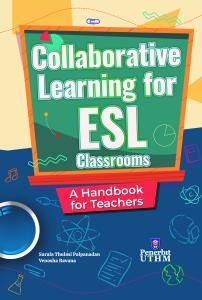Collaborative Learning for ESL Classrooms : A Handbooks for Teachers
Synopsis
This book a teaching support tool for teachers and researchers looking to expand their knowledge on the effective conduct of collaborative learning for ESL (English as a second Language) teaching and learning. It includes comprehensive descriptions of facilitation, active interaction, feedback and reflection strategies with ready-to-use materials such as lesson plan checklist, feedback forms and reflective journal entries. Teachers can also learn about conflict resolution in a collaborative learning environment based on suggestion given. The sample of ESL activities designed based on the strategies discussed in the book may also help teachers to practice and customise more ESL lessons with collaborative learning activities based on their preferences. All the ideas discussed in this book are applicable foe ESL classroom learning and also e-learning.
Downloads
References
A. Al-Mutairi, M. (2019). Kachru’s Three Concentric Circles Model of English Language: An Overview of Criticism & the Place of Kuwait in it. English Language Teaching, 13(1), 85. https://doi.org/10.5539/elt.v13n1p85
Abd Talib, M. A. (2019). The Learning of English Literature in Malaysia: a Review of Literature. Religación, 4, 68–74.
Abubakar, A. B., & Arshad, M. Y. (2017). Collaborative Learning and Skills of Problem-based Learning : A Case of Nigerian Secondary
Schools Chemistry Students. 11(27), 53–62. https://doi.org/10.5539/ass.v11n27p53
Almumen, H. A. (2020). Universal Design for Learning (UDL) Across Cultures: The Application of UDL in Kuwaiti Inclusive Classrooms. SAGE Open, 10(4). https://doi.org/10.1177/2158244020969674
Alshahrani, A. (2017). Power Distance and Individualism-Collectivism in EFL Learning Environment. Arab World English Journal, 8(2), 145–159. https://doi.org/10.24093/awej/vol8no2.10
Avci, H., & Adiguzel, T. (2017). A case study on mobile-blended collaborative learning in an English as a foreign language (EFL) context. International Review of Research in Open and Distance Learning, 18(7), 45–58. https://doi.org/10.19173/irrodl.v18i7.3261
Aziz, Z. A., & Khatimah, H. (2019). Enjoying Learning Writing through Facebook Group. Lingua Cultura, 13(2), 115. https://doi.org/10.21512/lc.v13i1.5513
Azman, H. (2016). Implementation and challenges of English language education reform in Malaysian primary schools. 3L: Language, Linguistics, Literature, 22(3), 65–78. https://doi.org/10.17576/3L-2016-2203-05
Blattner, G., & Dalola, A. (2018). I Tweet, You Tweet, (S)He Tweets. International Journal of Computer-Assisted Language Learning and Teaching. https://doi.org/10.4018/ijcallt.2018040101
Boling, E. C., Hough, M., Krinsky, H., Saleem, H., & Stevens, M. (2012). Cutting the distance in distance education: Perspectives on what promotes positive, online learning experiences. Internet and Higher Education, 15(2), 118–126. https://doi.org/10.1016/j.iheduc.2011.11.006
Chen, I. H., Gamble, J. H., Lee, Z. H., & Fu, Q. L. (2020). Formative assessment with interactive whiteboards: A oneyear longitudinal study of primary students’ mathematical performance. Computers and Education, 150(January). https://doi.org/10.1016/j.compedu.2020.103833
Collins, M., & Berge, Z. (1996). Facilitating Interaction in Computer Mediated Online Courses. Proceedings of the FSU/AECT Conference on Distance Learning. June 20-23,
Engku Atek, E. S., Hassan, I., Latiff Azmi, M. N., Azmi, N. J., & Yah Alias, M. H. (2020). Students’ Perceptions of the English Literature Component in Malaysian Secondary Schools. Language Related Research, 11(5), 125–144. https://doi.org/10.29252/lrr.11.5.125
Ghavifekr, S., Kunjappan, T., & Ramasamy, L. (2016). Teaching and Learning with ICT Tools: Issues and Challenges from Teachers’ Perceptions. Malaysian Online Journal of Educational Technology, 4(2), 38–57.
Gredler, M. E. (2012). Understanding Vygotsky for the Classroom: Is It Too Late? In Educational Psychology Review. https://doi.org/10.1007/s10648-011-9183-6
Hiew, W. (2012). English Language Teaching and Learning Issues in Malaysia: Learners’ Perceptions Via Facebook Dialogue Journal. Journal of Arts, Science & Commerce.
Hockly, N. (2000). Modelling and ‘cognitive apprenticeship’ in teacher education. ELT Journal, 54(2), 118–125. https://doi.org/10.1093/elt/54.2.118
Hu, C. C., Yeh, H. C., & Chen, N. S. (2020). Enhancing STEM competence by making electronic musical pencil for nonengineering students. Computers and Education, 150(123), 103840. https://doi.org/10.1016/j.compedu.2020.103840




